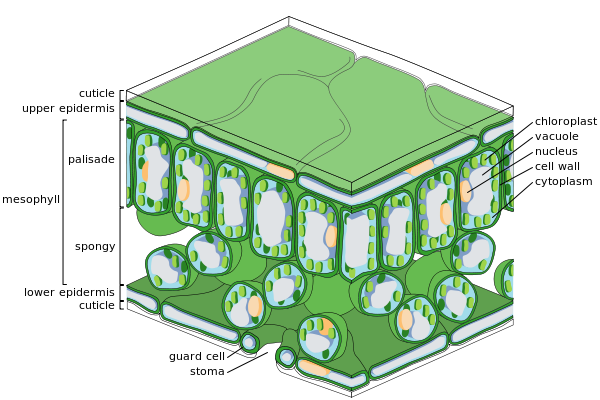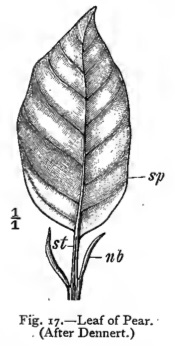Leaf function and variation
The primary function of a leaf is to photosynthesize.
The internal anatomy of a leaf is not addressed at the K-5 level. However, understanding it is important when one has to understand concepts like plant competition (especially competition for water), adaptations that help plants deal with different environmental conditions (especially drought and heat), and other real-world issues that are part of the K-5 curriculum. Here is is in a nutshell:

1) Leaves are covered with a waxy layer called a cuticle to retard water loss. This also blocks carbon dioxide uptake.
2) Carbon dioxide has to get into the leaf and dissolve in the water of the wet cell walls inside the leaf before it can be taken into the photosynthetic cells and used in photosynthesis.
3) Pores in the epidermis called stomata (singular: stoma or stomate, meaning "mouth") can open and close, restricting or allowing carbon dioxide uptake and water vapor loss.
4) Most of the water taken up by a plant is lost to evaporation from leaves as they open their stomata to obtain carbon dioxide.
5) [Relevant to later discussions of leaf adaptation]: a hot leaf will lose water more quickly than a cool leaf if they have the same number of stomata open the same amount. Why? Hot water evaporates quicker than cool water.
The diagram above is from Wikimedia Commons (author: Zephyris; url: http://en.wikipedia.org/wiki/Epidermis_%28botany%29#mediaviewer/File:Leaf_Tissue_Structure.svgz)
Leaves come in many different shapes, forms, and life-spans.

Basic parts of a leaf are the blade, the petiole (stalk of the leaf), and stipules (two structures at the base of the leaf or flanking it).
Some leaves do not have petioles: they are called sessile leaves.
Many species do not produced stipules. Stipules may vary widely among species that do produce stipules. In some species, stipules are small and fragile. In others, they are large and leaf- like. In yet others, they are hard little knobs, and in some they form thorns.
Some are simple leaves, with a single expanse of blade; others are compound leaves, with many separate little blades or leaflets. How can you tell if you are looking at a lot of little leaves or a lot of little leaflets on a single leaf? Look for the axillary bud. There should be an axillary bud in the axil of each leaf. View the University of Wisconsin's explanation of how to distinguish a compound leaf from a simple leaf at the following website: https://www.uwgb.edu/biodiversity/herbarium/trees/simple_compound_leaves01.htm . (This link opens in a separate tab or window.)
The drawings below show five leaves. Which is a compound leaf?
Some leaves live only a few weeks; others live for decades.
Deciduous leaves are leaves that all fall from the plant seasonally. Winter-deciduous plants are leafless during the winter. Drought-deciduous plants are leafless during the dry season.
Evergreen leaves typically live more than one year, resulting in a plant that is never leafless. (Note that you can have an evergreen plant with short-lived leaves, as long as leaves continually produced and always present on the plant.)
[More detail on different leaf shapes, characteristics that are important in identifying plants, will be covered in a later lesson.]